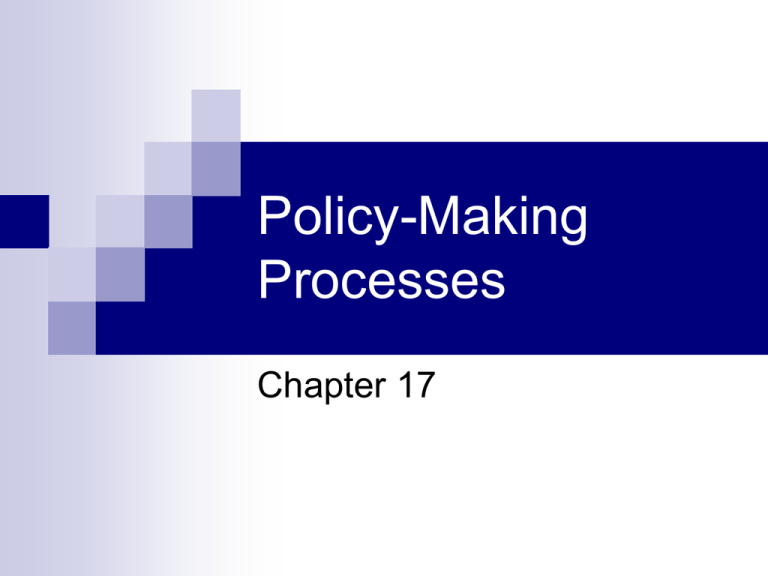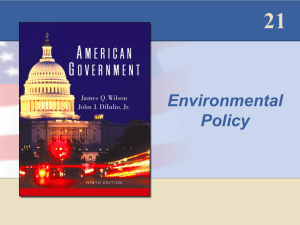
Policy-Making
Processes
Chapter 17
Chapter 17 Quiz
For each of the types of politics on the
grid, do each of the following:
1. Clearly label the type of politics.
2. Give a recent example of this type of
politics in action.
3. Explain who benefits from this action.
4. Explain who bears the cost of the action.
Policy making process once the
problem is identified:
Setting the Political Agenda
The political agenda: deciding what to
make policy about
The current political agenda includes
military, homeland security, taxes, energy,
welfare, and civil rights
Who sets? Business, media, interest
groups, politicians with agendas?
Shared beliefs determine what is legitimate
for the government to do—Examples?
Copyright © Houghton Mifflin Company. All rights reserved.
17 | 4
Scope of Government Action
Government always gets larger, policies persist
People generally believe that government
should continue to do what it is doing now
Changes in attitudes and events tend to
increase government activities
War,
crisis, natural disaster, recessions/depressions
Government growth cannot be attributed to one
political party
For more rules that we have covered, check out
the inset on the next slide!
Copyright © Houghton Mifflin Company. All rights reserved.
17 | 5
American System of Policymaking
Separation of Powers
Stalemate
between President & Congress is
inevitable (even with unified government.)
Different constituencies lead to pork barrel
politics, different timetables, different demands
Federalism
“All
politics are local” in the US
Funding and mandates may come from
Washington, but implementation is by states
Copyright © Houghton Mifflin Company. All rights reserved.
17 | 7
American System of Policymaking
The Power of Judicial Review
Can
declare actions, laws by any branch at
any level unconstitutional.
When other levels or branches ignore
decisions, gives “standing” for lawsuits.
The First (and Foremost) Rights
Free
speech now includes lobbying
lawmakers, airing campaign ads, protesting
funerals, giving campaign contributions, etc.
Limiting these is rarely upheld unless a
compelling reason is demonstrated.
Other Influences
Groups may react to a sense of relative
deprivation
The media helps place issues on the
political agenda (rarely report what goes
well)
The national government may later adopt
ideas pioneered by the states (Bottom up
approach!)
Copyright © Houghton Mifflin Company. All rights reserved.
17 | 9
Costs, Benefits, and Policy
Cost: any burden, monetary or nonmonetary, that some people must, or
expect, to bear from the policy
Benefit: any satisfaction, monetary or
non-monetary, that some people must, or
expect, to receive from the policy
Politics is a process of settling disputes
over who benefits/pays and who ought to
benefit/pay
Copyright © Houghton Mifflin Company. All rights reserved.
17 | 10
Figure 17.1: A Way of Classifying and
Explaining Politics of Different Policy Issues
Copyright © Houghton Mifflin Company. All rights reserved.
17 | 11
Kinds of Politics
Majoritarian politics: distributed benefits,
distributed costs
Interest group politics: concentrated
benefits, concentrated costs
Client politics: concentrated benefits,
distributed costs
Entrepreneurial politics: distributed
benefits, concentrated costs
Copyright © Houghton Mifflin Company. All rights reserved.
17 | 12
Majoritarian Politics
Distributed costs & distributed benefits.
Generally little opposition.
Ex.: Military & Security Spending
Everyone
pays in the form of taxes
Everyone benefits from the security provided
Budgets of military and homeland security
have grown.
People demand security.
Copyright © Houghton Mifflin Company. All rights reserved.
17 | 13
Interest Group Politics
Concentrated costs & concentrated
benefits…Crossfire!
Ex: labor unions seek government
protection of rights; businesses oppose to
preserve competitiveness in market
Dems. are pro-labor; Repubs. are pro-biz
The party in power, as well as crisis &
events, shape legislation.
Copyright © Houghton Mifflin Company. All rights reserved.
17 | 14
Client Politics
Concentrated benefit & distributed costs
Iron triangles are great examples
Recipient must be seen as deserving or
they lose legitimacy
“Agency capture” is likely when benefits are
focused and costs are dispersed—an
agency is created to serve a group’s needs
Ex. 1: Pork Barrel Legislation
Everybody
pays taxes, a small district benefits
Ex: natural disaster victims
Everybody
pays taxes, victims benefit
Copyright © Houghton Mifflin Company. All rights reserved.
17 | 15
Entrepreneurial Politics
Distributed benefits & concentrated costs
Relies on entrepreneurs to galvanize public
opinion and mobilize congressional support
Rachel
Carson, Ralph Nader are best examples
Policy Entrepreneur versus Captain of Industry
Ex: Environmental protection statutes (Clean
Air Act, NEPA, etc.)
Corporations
pay the costs, everyone benefits
Ex. 2: Consumer protection & recalls
Corporations
cover cost, everyone benefits
Copyright © Houghton Mifflin Company. All rights reserved.
17 | 16
Here & Now or Worry over Future?
Policies are not made sometimes on actual
costs, but perceived costs
Values also affect perception—Doing the
“right” thing
These perceptions also come in 2 camps:
Here
& now
Future quality of life
Ex: Gas dependency
Classification Activity
Form groups of 4
Take dots per team
For each scenario station:
Read the scenario
2. Place dot in the politics category it belongs
3. Move clockwise to next station
1.
Review answers.
Assignment
Read the red tile 1 on policy Symbaloo
board to introduce the difference between
fiscal and monetary policy.
Read pp. 492-509 in the old Wilson
textbook. Take notes by headings.
Bring a charged Chrome book to class.
Due Tuesday!

